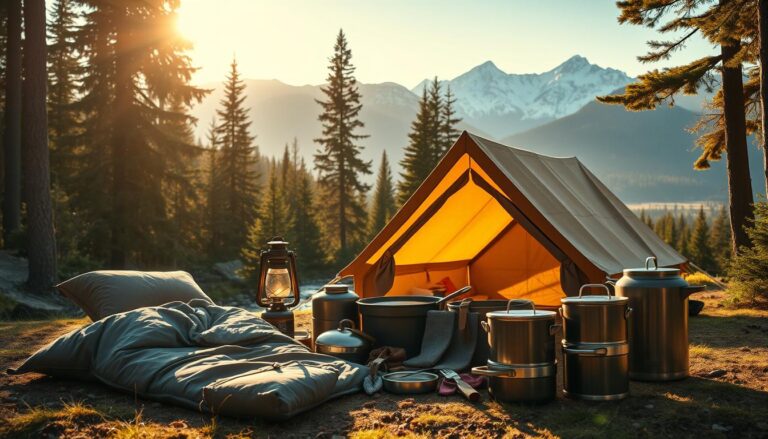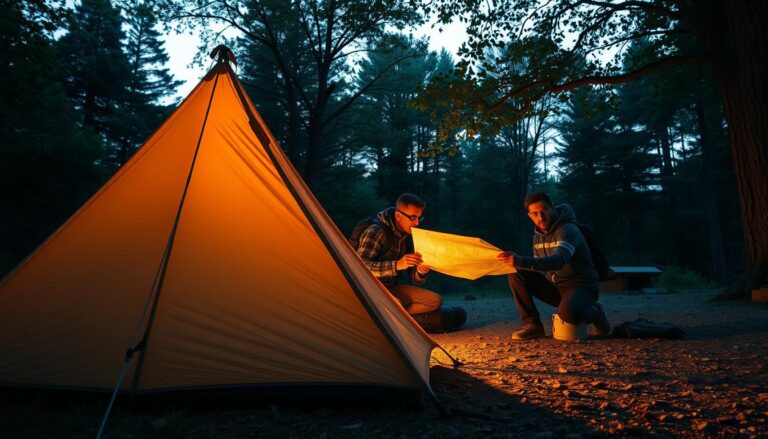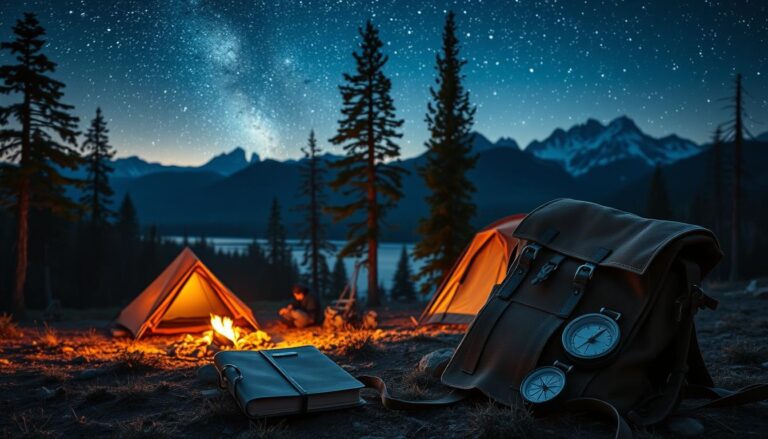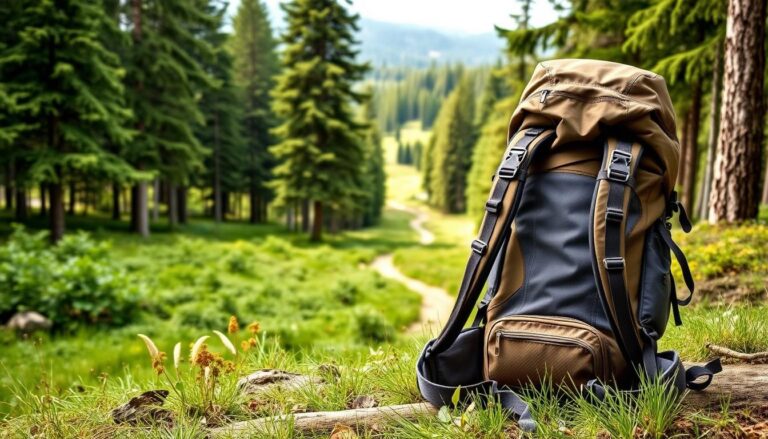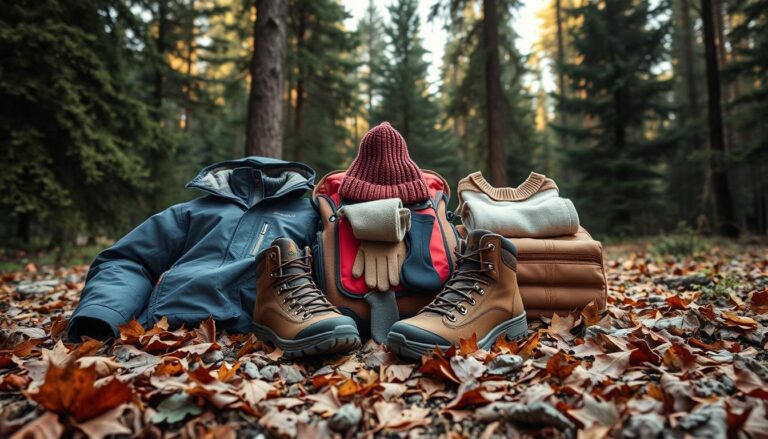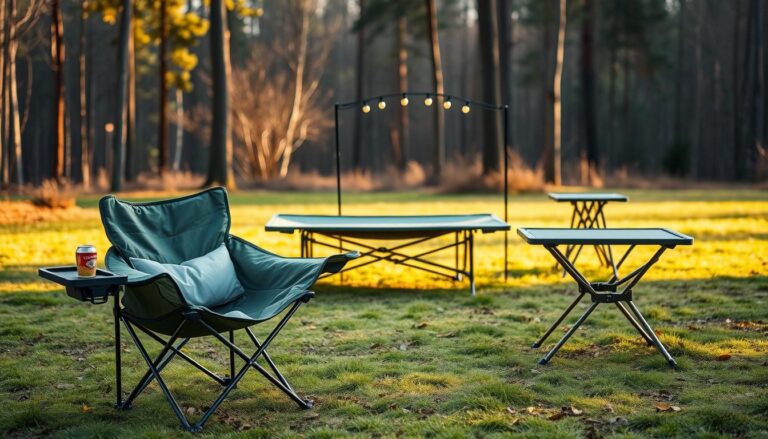Top 10 Sleeping Bags for Every Camping Season and Budget
I tested over 20 sleeping bags, including the Alps OutdoorZ Redwood and the Coleman Brazos. These bags range from warm to budget-friendly. I used GearLab’s methods to review them, focusing on how well they perform in real-world conditions.
Choosing the right sleeping bag depends on your camping needs. Whether you’re into lightweight backpacking or need warmth all season, this guide helps. It compares down vs. synthetic insulation and durability. Plus, it offers tips on picking the right bag for your body and weather needs.
Key Takeaways
- Top 10 sleeping bags cover winter to summer use cases.
- Testing included warmth retention and ease of packing.
- Alps OutdoorZ and Coleman models highlight extremes of performance and cost.
- Materials like nylon and down affect weight and durability.
- Guidance for maintaining gear to extend camping gear lifespan.
Why Choosing the Right Sleeping Bag Matters
For outdoor sleeping, the right sleeping bag is crucial. It’s your shield against the cold. My first cold-weather camping trip was a lesson in this. A bad bag made it a freezing experience.
Since then, I’ve learned three important things. Comfort, weight, and durability are key. They make all the difference.
Comfort and Warmth
Imagine a sleeping bag that feels like a warm blanket. Flannel-lined bags, like the Alps OutdoorZ Redwood, are cozy without being heavy. In winter, I choose bags with synthetic insulation that keeps me warm, even when wet.
Looking at warmth ratings and materials is important. It ensures you wake up warm, not cold.
Weight and Portability
- Backpackers know extra ounces add up fast
- Lightweight options like the REI Co-op’s 20-degree bag pack down to palm-sized stuff sacks
- Compact designs let you prioritize space for other gear
Durability and Materials
My favorite ultralight bag lasted three seasons. Its rugged 210D nylon shell was the reason. Brands like The North Face use ripstop fabrics to resist tears.
Investing in weather-resistant exteriors is smart. It keeps your bag safe from rain and rough surfaces.
Types of Sleeping Bags Explained
Knowing about sleeping bag styles is crucial for picking the right gear for your adventures. Each type meets different needs, like space, warmth, or being light. These choices are key to your backpacking essentials.
Rectangular Sleeping Bags
- Wide, boxy shape allows full movement
- Perfect for car camping or casual trips
- Thicker insulation layers for moderate climates
- Popular picks include the Kelty Cosmic 20 and REI Co-op Camp 20
Mummy Sleeping Bags
- Tapered hood-to-toe design reduces heat loss
- Down or synthetic fill for -20°F to 30°F ranges
- Top models like the Western Mountaineering Zephyr excel in cold
- Compressible but less spacious than rectangular styles
Backpacking Sleeping Bags
- Engineered for weight savings (often under 2 lbs)
- Compression sacks reduce pack volume for long trips
- Key backpacking essentials like the Mountain Hardwear Ghost Whisper combine 20D nylon with 800-fill down
- Features like draft tubes prevent cold spots during multi-day treks
Choosing the right style for your activity is key for the best performance. Whether you need room, warmth, or light gear, these categories have you covered. Always look for durability and season ratings when picking your next bag.
Top 10 Sleeping Bags for Different Seasons
Seasons require different levels of insulation. Here are top picks based on temperature ratings and user reviews. They match your camping needs:
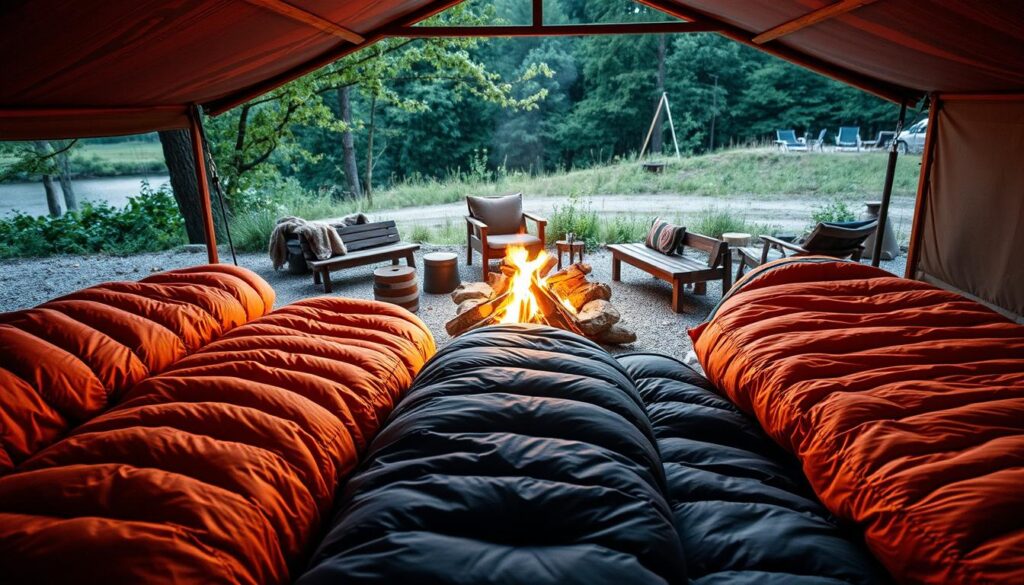
Best Winter Sleeping Bags
Cold-weather campers look for warmth. The Alps OutdoorZ Redwood stands out with 20°F down insulation. It’s perfect for sub-zero temps.
The Marmot Trestles is for extreme cold. It uses 850-fill down to keep you warm at -20°F.
Best Spring and Fall Sleeping Bags
Spring and fall need versatile gear. The REI Co-op Siesta Hooded 20 (20°F limit) works well in changing weather. It’s great for these seasons.
The Therm-a-Rest Quest 20 combines synthetic insulation with a draft collar. It’s perfect for 3-season use.
Best Summer Sleeping Bags
- Coleman Ultralite: Lightweight 35°F-rated bag with breathable nylon
- Sea to Summit Compression: Packs small yet maintains 45°F comfort
For summer, insulated sleeping bags with synthetic fills dry faster. Look for bags labeled “summer use” starting at 40°F.
Features to Look for in a Sleeping Bag
Choosing the right features is key to finding a sleeping bag that fits your needs. Lightweight sleeping bags are great because they are compact but still warm. Let’s explore what’s most important.
Insulation Types: Down vs. Synthetic
Down insulation is warm but loses its effectiveness when wet. Synthetic insulation, on the other hand, dries quickly and stays warm even when damp. The Kelty Galactic 30 is perfect for backpackers because it’s light and warm. But, if you’re in a wet area, the Marmot Trestles with synthetic insulation is a better choice.
- Down: Best for dry climates, packs smaller
- Synthetic: Better for humid or rainy regions
Waterproof and Breathable Fabrics
Outer shell materials like Pertex or nylon keep you dry. Look for DWR (durable water repellency) coatings. Also, breathable fabrics help prevent moisture buildup inside. Lightweight sleeping bags often use 20D or 10D fabric weights to be less bulky.
Zipper Quality and Design
Full-length zippers let in more air but can let cold air in. Half-zip designs help control drafts better. The TETON Sports Polara 3-in-1 has dual zippers for adjustable airflow. Make sure the zippers have anti-snag teeth to avoid tears.
Budget-Friendly Sleeping Bags
Looking for a sleeping bag doesn’t have to empty your wallet. There are affordable options for every need, but things change when it gets cold. For colder weather, you need better insulation and materials.
Best Affordable Options Under $50
- Coleman Brazos: Great for those on a tight budget. Its polyester fill is good for mild weather, but not for freezing temps.
- REI Co-op Midsized: A spacious option for under $50. It’s perfect for three-season use, but not for long cold weather sleeping bags needs.
Great Mid-Range Choices Between $50-$150
Mid-range options offer a good balance of price and performance. The Kelty Tru.Comfort 20 Doublewide is a standout with a 20°F rating. It’s reliable for cool nights without spending too much. Synthetic insulation is a good choice here because it stays warm even when wet.
Value for Money: Premium Bags
Premium bags like the Kelty Tru.Comfort 20 Doublewide show that you don’t have to spend a lot for quality. These bags often use down insulation for better warmth and less weight. When you’re investing, look for high fill power and durable shells.
Best Brands for Sleeping Bags
Choosing the right brand is key to getting quality best sleeping bags for your adventures. After trying many, three brands stand out for their reliability and innovation.
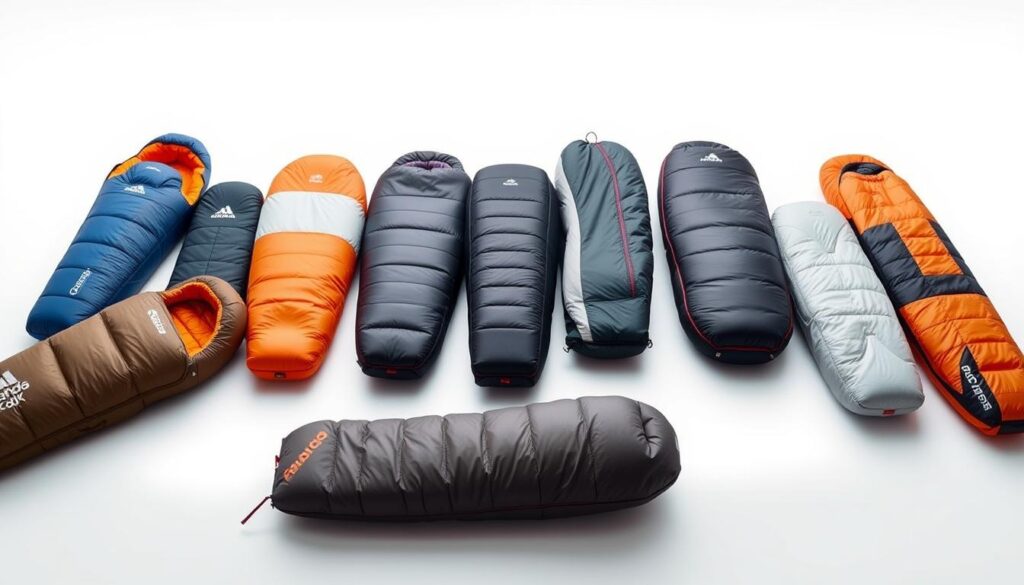
Coleman
Coleman is my top pick for affordable options. They offer tough designs that won’t empty your wallet. Their best sleeping bags are made to last through tough weather. Models like the Coleman WeatherMaster are favorites among families and new campers.
The North Face
The North Face leads in innovation. Their Thermoball and EcoTrail lines mix advanced insulation with green materials. I’ve used their gear for tough trips, showing they care about both performance and the planet.
REI Co-op
REI focuses on comfort, offering wide-sizing options and designs that put users first. Their Co-op Down 20° is a top pick, blending warmth with light weight. As a member, I’ve seen their commitment to fair prices and ethics.
Each brand has its strengths—Coleman for value, The North Face for tech, and REI for inclusivity. Look into their products to find the best fit for your camping style and the weather. Choose brands that offer warranties and support.
Care and Maintenance of Sleeping Bags
Proper care keeps your sleeping bag warm and functional for years. Regular maintenance also keeps the insulation quality high. This is crucial in sleeping bag reviews for durability. Follow these steps to extend your gear’s life.
Cleaning Techniques That Work
Always check the manufacturer’s instructions first. Use mild detergent and a front-loading washing machine. Never use a top-loading machine, as it can damage the stitching. Also, avoid fabric softener to keep the insulation working well.
Air-dry the bag outdoors thoroughly to prevent mold. Look at sleeping bag reviews for care tips specific to your brand.
Storage Tips for Longevity
Store your bag loosely in a stuff sack, not compressed. Down-filled bags need space to keep their loft. For seasonal storage, use a mesh bag to let air circulate.
Avoid storing in attics or humid basements to prevent moisture buildup.
Minor Repairs to Tackle Yourself
- Zipper jams? Lubricate with beeswax or lubricant.
- Small tears? Use a sewing kit designed for outdoor gear.
- Misplaced insulation? Fluff manually after washing to redistribute loft.
Most brands like The North Face or REI Co-op offer repair guides online. Fix damage quickly to avoid expensive replacements.
Tips for Choosing the Right Sleeping Bag for You
Every camper has their own needs. Start by finding a sleeping bag that fits your body and meets your goals. Here’s how to find the right one:
Personal Preferences and Body Types
Your body shape and comfort style are important. Taller campers need longer bags, and side sleepers prefer wider shoulders. Down insulation keeps you warm but loses heat when wet. Synthetic fills dry faster.
Test sizes in-store or use brand-specific sizing charts for the best fit.
- Check bag length: 2-4 inches extra for leg and headroom
- Consider hood design for head insulation
Weather Considerations
Temperature ratings are more than just numbers. A -20°F bag is perfect for winter, but spring might need a 3-season option. Layering your clothes inside the bag can make it warmer.
Look for water-resistant shells if you expect rain.
Expected Usage
Think about how you’ll use the bag. Backpacking? Choose lightweight bags to save energy. Car camping? Bulky styles are okay.
For frequent use, look for durability. Ripstop nylon or double-zip designs are good choices.
- Day hikers: Pick under 2 lbs
- Winter campers: Prioritize fill power and draft tubes
Conclusion: Finding Your Perfect Sleeping Bag
Choosing the right sleeping bag is more than just buying something. It’s about making your outdoor adventures safer and more comfortable. By considering insulation, materials, and the season, you can find a bag that fits your needs perfectly.
Recap of Key Features
Insulation type is key for warmth. Down bags are light and packable, but synthetic bags keep you warm even when wet. Durable fabrics like nylon or polyester help your bag last longer. Make sure the temperature rating matches your climate, whether it’s cold winter nights or warm summer evenings.
Encouragement to Explore Options
Start by thinking about your budget. If you’re a casual camper, look at budget-friendly options like Coleman’s lightweight bags. For harsher conditions, consider premium brands like The North Face or REI Co-op. Try out different bags to find one that fits you well. Proper care, like cleaning and storing, will keep your bag in top shape.
With so many choices, you can find a bag that suits your style and climate. Whether you’re backpacking or car camping, the right sleeping bag makes every night restful. Choose a bag that balances warmth, weight, or budget, and get ready for your next adventure.

